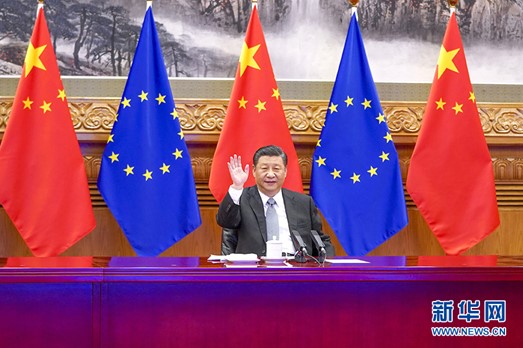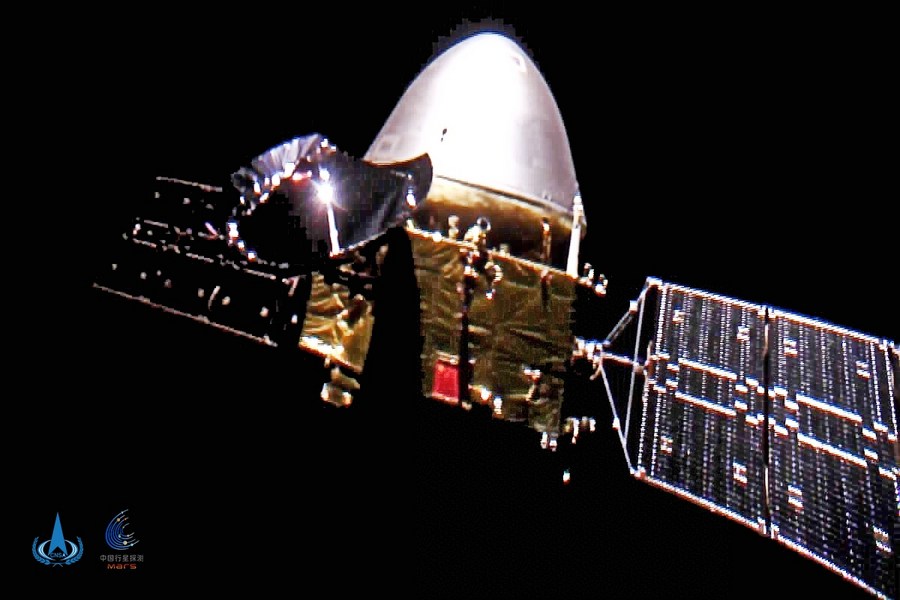By LuoShanshan (Peoples Daily)16:05, January 01, 2021
Chinese President Xi Jinping and EU leaders announced on Dec. 30 that the two sides have completed investment agreement negotiations as scheduled.
The announcement was made on a meeting between Xi and German Chancellor Angela Merkel, French President Emmanuel Macron, President of the European Council Charles Michel and President of the European Commission Ursula von der Leyen via video link.
The balanced, high-standard and mutually beneficial deal reached between the worlds largest developing country and major developed economies demonstrates Chinas determination and confidence to push high-level opening up, and will provide greater market access, higher level of business environment, stronger institutional guarantees and brighter cooperation prospects for mutual investment.
It will also greatly boost world economic recovery in the post-pandemic era and enhance the international communitys confidence in economic globalization and free trade, making significant contributions to the building of an open world economy.
The China-EU talks on the investment pact were launched seven years ago, and have gone through 35 rounds of official negotiations.

Chinese President Xi Jinping meets with German Chancellor Angela Merkel, French President Emmanuel Macron, President of the European Council Charles Michel and President of the European Commission Ursula von der Leyen via video link in Beijing, Dec. 30, 2020. They announced that China and the EU have completed investment agreement negotiations as scheduled. (Photo by Li Xueren/Xinhua News Agency)
China has always attached great importance on the pact talks. On multiple occasions Xi has urged to accelerate the negotiations, including the opening ceremony of the China International Import Expo and the G20 summits, and has exchanged views with leaders of the EU and its member states for multiple times. The Chinese and EU leaders have always kept an eye on the long-term development of China-EU relations and constantly paid high attention to the pact talks, which provided basic guarantee for todays achievements.
The investment agreement between the two sides is in favor of China.
To accelerate the negotiations is a major measure of China taken at its own pace to promote high-level opening up on the premise of safeguarding its security and development interests. The investment treaty matches high-level international economic and trade rules and focuses on institutional opening-up. Both sides have promised to lower market access, made balanced, comprehensive and fair competition rules, and for the first time introduced chapters on sustainable development.
The high-level negotiation results will help China build a higher-level new open economy, establish a dual circulation development pattern in which domestic economic cycle plays a leading role while international economic cycle remains its extension and supplement, and build a business environment that is law-based, internationalized and business-friendly.

Chinese President Xi Jinping meets with German Chancellor Angela Merkel, French President Emmanuel Macron, President of the European Council Charles Michel and President of the European Commission Ursula von der Leyen via video link in Beijing, Dec. 30, 2020. They announced that China and the EU have completed investment agreement negotiations as scheduled. (Photo by Li Xueren/Xinhua News Agency)
The investment agreement between the two sides is in favor of both China and the EU.
China is the EUs largest trading partner, while the EU is Chinas second largest trading partner, third largest source of investment and third largest investment destination. The two sides have a stock of outbound direct investment of over $200 billion. They have received constant benefits from investment cooperation over the years, and enjoy huge potential of further expanding the cooperation.
The investment deal will further expand market access between the two sides, from which the enterprises from China and the EU will have better investment protection and reap fruitful results from more investment opportunities. The flow of commodities, technologies, services, capital and personnel will also be better facilitated and consolidated, which is conducive to the long-term healthy and stable development of China-EU relations.
The investment agreement between the two sides is in also favor of the world.
The economic globalization has run up against headwinds; protectionism and unilateralism are on the rise; and the world economy has been severely impacted by COVID-19. As two of the worlds stabilizers and major economies, China and the EU have jointly released a positive signal to safeguard multilateralism and the rule-based open world economy by finishing the investment pact talks. This will better strengthen the dual engines driving the global economy and inject more certainty and development impetus.

Train X8020/19 departs Jinhua, east Chinas Zhejiang province, for Dourges, France on Nov. 26, carrying 82 TEUs (twenty-foot equivalent units) of cargos. (Photo by Shi Bufa/Peoples Daily Online)
The investment deal between China and the EU is a hard-won result. Next, the two parties shall launch follow-up work such as text review, as soon as possible to form legal text, and accelerate their approval procedures, so as to strive for an early signing and implementation for the benefits of both the enterprises and people from the two sides.
China cannot develop in isolation from the rest of the world, nor can the world as a whole maintain prosperity without China. Standing at a new point of history, it is expected that China and the EU can meet each other halfway and ride the tide, bring bilateral trade and economic ties onto a new level, build a strong power for global cooperation, and make an example of win-win cooperation, so as to jointly promote the recovery and prosperity of the world economy.
![]()





